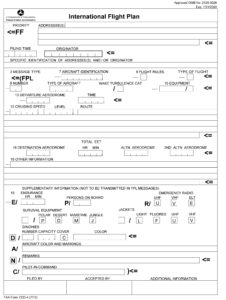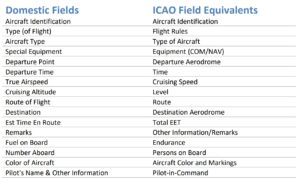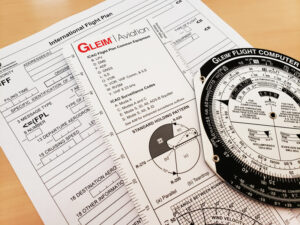
After several years of planning and coordinating between the FAA, flight plan vendors, and upgrading ATC equipment, the mandatory use of ICAO flights plans takes effect on August, 27th 2019. This means the FAA will require all flight plans, domestic or international, to be filed with the ICAO format. For the past few years, the FAA urged pilots to file ICAO format flight plans instead of using the FAA domestic flight plan form to familiarize themselves with the new flight plan format before it became mandatory in the United States.
Guidance on the ICAO flight plan form is available in the Aeronautical Information Manual (AIM) Section 1, Par. 5-1-9. A detailed discussion on the matter has been posted to the FAA website here. The FAA has posted additional guidance on its website that lays out equivalent fields on the ICAO format flight plan, and how to fill them up prior to filing (see image below).
Although the differences between the FAA flight plan and the ICAO flight plan are minimal, they require attention to get the details correct. The most significant change concerns equipment suffixes, which are located in item 10 of the ICAO flight plan. The previous single-letter FAA codes used to denote entire avionics packages available onboard an aircraft cannot be used on the ICAO flight plan. The ICAO format requires you to denote the individual equipment you have and the capabilities of your avionics system. For example, if you have a standard avionics that includes VHF, VOR, and ILS, you would file “S.” However, if you also have an IFR-approved GPS, the letter “G” should be added to the box, along with the letter “R” if the aircraft is able to accept Performance Based Navigation (PBN) routes and procedures.

Item 10 includes a forward slash which creates a sub-item, Item 10b, for you to list your transponder equipment code. If your aircraft is Mode A or C capable, then fill Item 10b with “A” or “C” respectively. If your aircraft is Mode S capable, there are seven different options for you to choose from (i.e. E, H, I, L, P, S, X). The most common transponder codes will likely be E (for mode S, ID, altitude, and ADS-B), or S (for mode S, ID, and altitude). The description for all these codes can be found in the AIM regarding ICAO flight plans listed above.
There are several safety-related improvements with the implementation of the ICAO flight plan that domestic pilots should be aware of.
- There will be an increase in size of the departure and destination fields to allow a greater variety of entry types, including Special Flight Rules Area (SFRA) flight plans.
- The flight plan will include a wake turbulence category based on the maximum certified take-off mass of the aircraft. The options are ‘H’ for heavy aircraft weighing 300,000 lbs. or more, ‘M’ for medium aircraft weighing between 15,000 lbs. to 300,000 lbs., and ‘L’ for aircraft weighing 15,000 lbs. or less.
- The supplemental pilot information and VFR flight plan will be transmitted to the destination facility to reduce search and rescue response times.

When filing a flight plan, pilots will be required to use the ICAO format for all future cross-country flights. It is imperative that pilots are adept in knowing how to complete the form. Online flight plan filing vendors have additional guidance to help you understand each block on the flight plan form. If you are used to filing your flight plan over the phone, a flight service briefer can prompt you for the necessary information in the order it is required, just advise your briefer that you are requesting assistance.
Pilots in training should be aware that the FAA will begin to incorporate questions on the knowledge tests regarding the ICAO flight plan. To prepare for the transition, Gleim Aviation FAA Knowledge Test Prep products have already been updated to include study guides and questions on the matter. Additionally, since late 2017, the Gleim E6B flight computer, which you may take into your FAA knowledge test, already includes the most commonly used ICAO equipment codes printed on it.
Gleim would like to know if you you see any ICAO flight plan questions on your knowledge test. If you have any questions or would like to share your feedback, please use the contact form online, or call us at 800.874.5346, ext. 471.
Written by Ryan Jeff, Gleim Aviation Research Assistant

